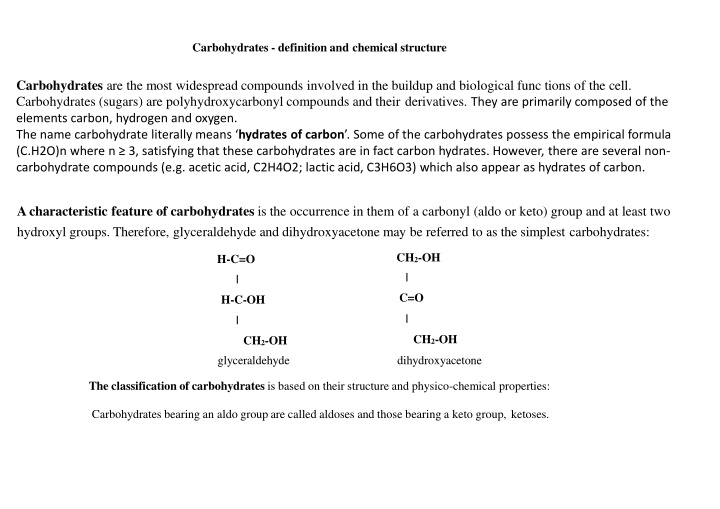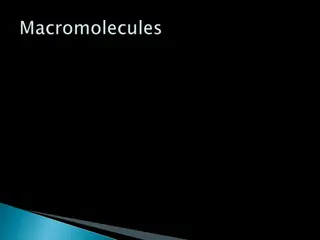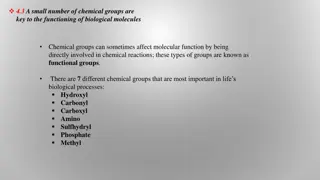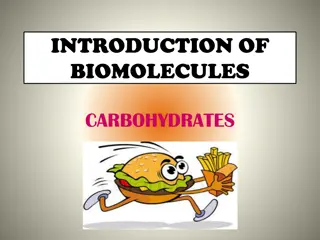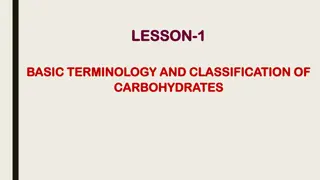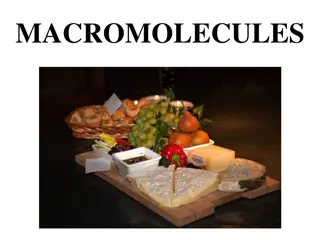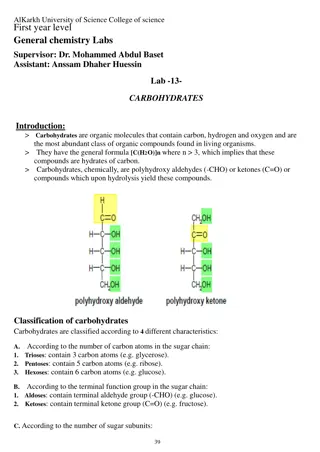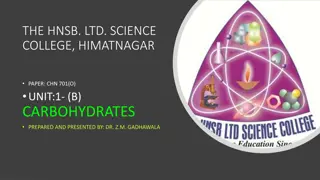Chemical Structure and Classification of Carbohydrates
Carbohydrates are essential compounds in cellular functions, categorized into monosaccharides, oligosaccharides, and polysaccharides. They are classified based on their structure and physico-chemical properties, including aldo and keto groups. The optical activity of sugars is defined by their asymmetric carbon atoms. Carbohydrates play crucial roles in biological processes, serving as energy sources and structural components in cells.
Download Presentation

Please find below an Image/Link to download the presentation.
The content on the website is provided AS IS for your information and personal use only. It may not be sold, licensed, or shared on other websites without obtaining consent from the author.If you encounter any issues during the download, it is possible that the publisher has removed the file from their server.
You are allowed to download the files provided on this website for personal or commercial use, subject to the condition that they are used lawfully. All files are the property of their respective owners.
The content on the website is provided AS IS for your information and personal use only. It may not be sold, licensed, or shared on other websites without obtaining consent from the author.
E N D
Presentation Transcript
Carbohydrates - definition and chemical structure Carbohydrates are the most widespread compounds involved in the buildup and biological func tions of the cell. Carbohydrates (sugars) are polyhydroxycarbonyl compounds and their derivatives. They are primarily composed of the elements carbon, hydrogen and oxygen. The name carbohydrate literally means hydrates of carbon . Some of the carbohydrates possess the empirical formula (C.H2O)n where n 3, satisfying that these carbohydrates are in fact carbon hydrates. However, there are several non- carbohydrate compounds (e.g. acetic acid, C2H4O2; lactic acid, C3H6O3) which also appear as hydrates of carbon. A characteristic feature of carbohydrates is the occurrence in them of a carbonyl (aldo or keto) group and at least two hydroxyl groups. Therefore, glyceraldehyde and dihydroxyacetone may be referred to as the simplest carbohydrates: CH2-OH | H-C=O | C=O H-C-OH | | CH2-OH CH2-OH glyceraldehyde dihydroxyacetone The classification of carbohydrates is based on their structure and physico-chemical properties: Carbohydrates bearing an aldo group are called aldoses and those bearing a keto group, ketoses.
Based on their physico-chemical properties, carbohydrates are divided into: - neutral species (those containing hydroxyl and carbonyl groups only: glucose) - basic (those containing, alongside the aforementioned groups, an amino group:amino saccharides) - acidic (those containing, except hydroxyl and carbonyl groups, carboxyl moieties also: glucuronic acid). Based on their chemical structure, carbohydrates are divided into: monosaccharides, or monoses, which are simple carbohydrates, oligosaccharides, which are carbohydrates possessing two to ten monosacchride units linked by glycoside bonds, polysaccharides, or glycans, which are high-molecular carbohydrates containing more than ten monosaccharide units linked by glycoside bonds. Monosaccharides, or monoses, are simple carbohydrates. The names of all monosaccharides end in ose. The group name of monosaccharides indicates the number of carbon atoms and the presence of an appropriate carbonyl group (aldo or keto). For example: monosaccharides possessing five carbon atoms are called pentoses and taking into account the occurrence of an aldehyde group, aldopentoses.
If the monosaccharides in question contain a keto group, they are called ketopentoses. Carbohydrates with six carbon atoms are called, respectively, aldohexoses and ketohexoses.
Optical activity of sugars: Optical activity is a characteristic feature of compounds with asymmetric carbon atom. When a beam of polarized light is passed through a olution of an optical isomer, it will be rotated either to the right or left. The term dextrorotatory (d+) and levorotatory (l ) are used to compounds that respectively rotate the plane of polarized light to the right or to the left. An optical isomer may be designated as D(+), D( ), L(+) and L( ) based on its structural relation with glyceraldehyde. It may be noted that the D- and L-configurations of sugars are primarily based on the structure of glyceraldehyde, the optical activities however, may be different. Monosaccharides belong to either L-(levorotatory) or D-(dextrorotatory) series depending on the L- or D- configuration of substituents at the asymmetric carbon atom farthest from the carbonyl group in a given monosaccharide. For example, in hexoses, this carbon is C-5.
In aqueous solution, monosaccharides exist either in the form of an unfolded chain, or as a cyclic structure. Cyclic monosaccharides do not occur in trioses and tetroses but, starting with pentoses, a spontaneous reaction takes place between one of the hydroxyl groups and the carbonyl group leading to the closure of a ring. In such a manner, for example, five-membered and six-membered rings are formed. The hydroxyl at the first carbon atom of a cyclic monosaccharide is called the half-acetal hydroxyl. It is essential for reducing properties of carbohydrates.
D-Glucose (aldohexose) D-Glucose depicted in Haworth projection Chemical structures of carbohydrates-monosaccharides
Monosaccharide derivatives: The modification of available functional groups, or the introduction of substituents into the molecule of a monosaccharide produces various monosacchride derivatives. 1 Amion saccharides 2 Glycosides saccharides 3 Deoxy saccharides These are used in generating diverse polymeric carbohydrates. Some of the derivable species may act as intermediary metabolites. deoxy-D-ribose (or simply: deoxyribose) forms part of deoxyribonucleosides and deoxyribonucleotides, which 2- are structural monomers of DNA. Many monosaccharides are involved in the synthesis of a very important group of compounds called glycosides. In particular, ribose and deoxyribose make part of the aforementioned nucleosides and nucleotides which are N-glycosides.
Chemical structure of monosaccharide derivatives Of importance is the role of aminosugars, or aminodeoxysugars. D-glucosamine is used in the buildup of essential structural polysaccharides, i.e. hyaluronic acid. D-galactosamine takes part in the synthesis of polysaccharides of cartilage tissue.
Biological importance of monosaccharides: In the cell, the monosaccharides are used as a source of energy. Monosaccharides (as well as polysaccharides) as distinct from other compounds, are an energy substrate for the cells of human and animal organisms both in the presence and in the absence of oxygen. Moreover, monosaccharides and their derivatives are involved in the buildup of diverse biological molecules, i.e. in the performance of a plastic function. Oligosaccharides, are carbohydrates possessing two to ten monosaccharide units linked by glycoside bonds. They differ from one another in the monosaccharide composition and in the type of glycoside bond. Among the most widespread oligosaccharides worth mentioning are: sucrose (cane sugar, beet sugar) widely distributed in plants, maltose (malt sugar), a product of partial hydrolysis of starch in plants and glycogen in animals, lactose (milk sugar) found in the milk of all mammals, trehalose, present in numerous lower and higher fungi.
Chemical structures of disaccharides: sucrose (left) and lactose Oligosaccharides are found in the cells and biological fluids in a free state as well as constituents of covalently bonded carbohydrate-protein complexes (glycoproteins and proteoglycans).
